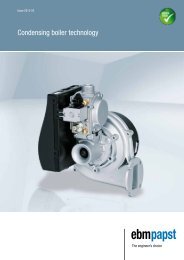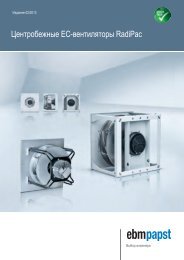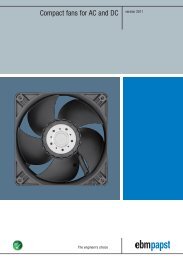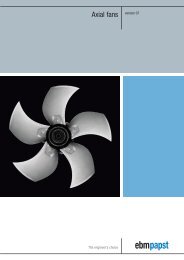Drive technology for AC and DC
Drive technology for AC and DC
Drive technology for AC and DC
Create successful ePaper yourself
Turn your PDF publications into a flip-book with our unique Google optimized e-Paper software.
Definitions <strong>for</strong> <strong>DC</strong> motorsNominal voltage U BN [V <strong>DC</strong>]The <strong>DC</strong> voltage supplied to the <strong>DC</strong> motor. All nominal data in the technicaltables of the individual motors is based this voltage. However, the motorapplication is not limited to this voltage. Changing the voltage results in aparallel shift of the motor curve. The lower voltage limit is defined by thecommutator contact resistance <strong>and</strong> the start-up behaviour of the motor.The lower limit results from the mechanical ceiling speed of the motor. Inevery case, when selecting the voltage <strong>and</strong> defining the operating point,thermal overload of the motor in continuous operation or the selectedoperating cycle must be avoided. The ripple of the supply voltage shouldnot exceed 3-5 % in normal operation, as higher ripple means poorer efficiency<strong>and</strong> control quality <strong>and</strong> corresponding speed fluctuations.Nominal speed n N [rpm]The speed at which the motor can be operated <strong>for</strong> long periods at anambient temperature of 40 °C <strong>and</strong> with output of the nominal torque ina thermally conductive installation. It is an operating point at the max.motor curve.Nominal torque M N [mNm]The torque that the motor can output <strong>for</strong> long periods at an ambient temperatureat 40 °C <strong>and</strong> with output of the nominal torque in a thermallyconductive installation.Nominal current I N [A]The current drawn from the <strong>DC</strong> voltage source as the supply current whenthe motor outputs nominal torque at nominal speed.Nominal output power P N [W]The product of nominal torque <strong>and</strong> nominal angular velocity. When calculatingthis value, the tolerances <strong>for</strong> the individual values listed in the specificationdata sheets must be taken into account. In the electromagneticdesign of the motors, the nominal operating point is defined with considerationof the fact that the nominal output corresponds approximately tothe maximum permitted long-term output power of the motor.N MNω N = nNM N = ca. 0,1 M N nNP =π30Rated efficiency η N [%]Indicates the ratio in % of the mechanical outputpower to the absorbed electrical output relative tothe nominal operating point. Typically, the nominaloperating point is close to the optimum efficiency. .Speed at no-load operation n L [rpm]The speed that takes effect at the nominal voltage<strong>and</strong> with unloaded motor. For the <strong>DC</strong> motor, it isproportional to the applied supply voltage.The theoretical possible speed at no-load operationcan, in some cases, be limited by the mechanicalceiling speed.Start-up torque M A [mNm]The torque that the motor can output <strong>for</strong> shortperiods at speed "0" rpm <strong>and</strong> current draw in theamount of the start-up current at start-up or asholding torqueStart-up current I A [A]The current drawn from the <strong>DC</strong> voltage source asthe supply current if the motor outputs "0" rpm asthe start-up torque. If the power supply used has adesign that is too weak, it may not be possible toreach this point. In this case, the maximum possiblestart-up torque is limited by the power pack.Induced current U imax [V/1000 rpm]The value of the induced current in the motor per1000 rpm. It is a measure <strong>for</strong> the electromagneticdesign of the motor. In no-load operation, the inducedcurrent is approximately equal to the appliedsupply voltage (minus the voltage loss via theohmic resistance of the winding). Torque-<strong>for</strong>mingcurrent no longer flows; as a result, no more torquecan be output to the shaft in no-load operation. Thevalues specified in the technical data are based onan ambient temperature of 25 °C.156








